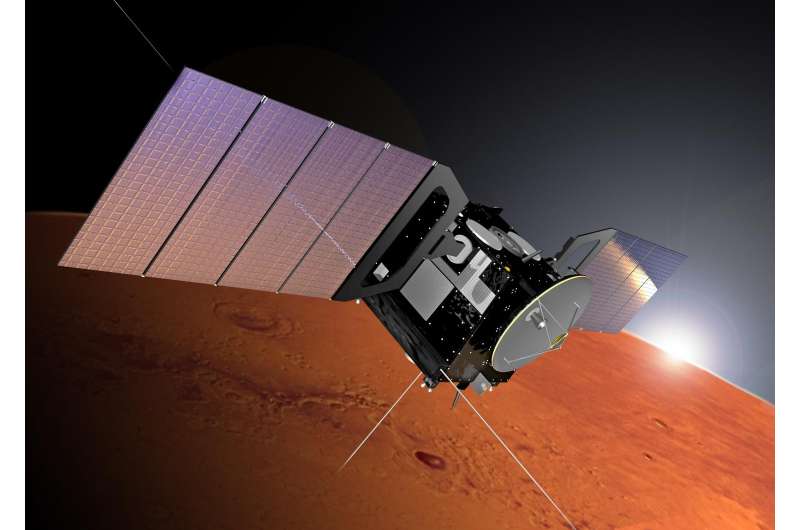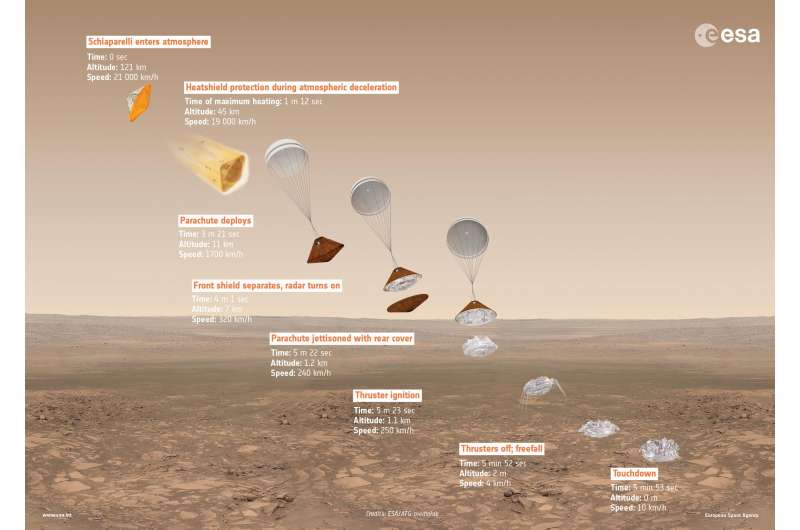Mars Express lifted off from Baikonur Cosmodrome aboard a Soyuz–Fregat rocket on 2 June 2003. It entered orbit around Mars on 25 December that year and reached its operational orbit in January 2004. The initial mission duration was one martian year (687 Earth days), completed in September 2005. Credit: ESA/Alex Lutkus
ESA's first Mars orbiter will provide an important helping hand when the second arrives at the Red Planet in October.
Following lift off in March, the ExoMars Trace Gas Orbiter (TGO) and the Schiaparelli lander are now enroute to Mars, with arrival set for 19 October.
Once orbiting Mars, TGO will begin analysing rare gases in the planet's atmosphere, especially methane, which on Earth points to active geological or biological processes.
Meanwhile, Schiaparelli will demonstrate the technology needed to make a controlled landing.
But they have to arrive at the planet first, and that's where the 13 year-old Mars Express will lend a crucial helping hand – or, rather, ear.
Separation, atmospheric entry, descent, landing
On 16 October, Schiaparelli will separate and, three days later, descend and land as TGO enters orbit.
On landing day, ESA's Mars Express, which has been delivering spectacular science data since 2003, will record signals from Schiaparelli for mission control to confirm a safe arrival and later reconstruct its descent.
"This will use the Mars Express Melacom communication system, originally carried for communications with the Beagle 2 lander and NASA rovers," says James Godfrey, Mars Express deputy spacecraft operations manager.
"This will enable Mars Express to detect and record critical Schiaparelli descent events, such as entry into the atmosphere, parachute deployment, heatshield release, touchdown and start of surface activities."
The orbit of Mars Express was adjusted in February for it to be in the right part of the martian sky to hear the signals transmitted from the descending Schiaparelli.
Overview of Schiaparelli’s entry, descent and landing sequence on Mars, with approximate time, altitude and speed of key events indicated. Schiaparelli is scheduled to separate from TGO on 16 October 2016, three days before arriving at Mars. Twelve hours after separation, the TGO will perform a course correction to avoid entering the atmosphere, and will continue into Mars orbit. Then, on 19 October, Schiaparelli will enter the atmosphere at an altitude of about 121 km and a speed of nearly 21 000 km/h. In the three to four minutes that follow, it will be slowed by the increasing atmospheric drag, with the front shield of the aeroshell bearing the brunt of the heating. This will slowly melt and vaporise, allowing the absorbed heat to be carried away from the rest of the spacecraft. Once the speed has decreased to around 1700 km/h Schiaparelli will be 11 km above the surface and a parachute will be deployed. The parachute canopy will unfurl in less than a second, and, 40 seconds later, allowing for oscillations to die down, the front shield of the aeroshell will be jettisoned. The parachute will slow Schiaparelli to around 250 km/h, and then the back half of the aeroshell, with the parachute attached to it, will also be jettisoned. It will be drawn rapidly away from Schiaparelli, which will now be completely free of the aeroshell that had kept it safe en route to Mars. Schiaparelli will then activate its three hydrazine thrusters to control its speed. Radar will continuously measure the height above the surface. At an altitude of around 2 m, Schiaparelli will briefly hover before cutting its thrusters, leaving it to free fall. The touchdown speed will be a few metres per second, with the impact absorbed by a crushable structure similar to the crumple zone in a car, on the underside of the lander, preventing damage to the rest of the module. The entire entry, descent and landing sequence will be complete in less than six minutes. Credit: ESA/ATG medialab
Tight coordination for Mars landing
On 19 October, about 80 minutes before landing, Schiaparelli will wake up and a few minutes later begin transmitting a beacon signal.
Mars Express will already have pointed Melacom's small antenna to the spot above the planet where Schiaparelli will appear, and will begin recording the beacon, turning to follow the descent path.
"Recording will continue through touchdown and the first 15 minutes of surface operation, after which Schiaparelli will switch off and Mars Express will stop recording," says Simon Wood, Mars Express spacecraft operations engineer.
"Then, Mars Express will turn its main antenna towards Earth and begin downloading data that contain the first in-situ confirmation from Mars of Schiaparelli's arrival and landing."
Melacom's software was recently updated to be compatible with Schiaparelli's transmitter. On 15 June, it will be tested while flying over NASA's Curiosity rover, which will transmit a signal similar to Schiaparelli's.
Mars Express won't be the only set of 'ears' listening in to Schiaparelli's descent that day.
At Mars, NASA's Mars Reconnaissance Orbiter will monitor signals from Schiaparelli, but only after landing, as it comes within view.
TGO, while firing its engine to brake into orbit, will record Schiaparelli's descent and landing, but these data can only be downloaded some hours later.
In the following days, Mars Express and NASA's three orbiters will each serve as data relays, overflying Schiaparelli's landing site in Meridiani Planum once or twice per day, picking up signals from the lander during its surface mission of two–four days, and relaying them to Earth.
Mars Express will also contribute to Schiaparelli's mission with remote-sensing measurements over the landing site for several weeks before.
"The Mars Express science team is looking forward to TGO's arrival at Mars, which will allow combining capabilities of both spacecraft in investigating the Red Planet," says Dmitri Titov, Mars Express project scientist.
"It's perhaps fitting that ESA's newest mission to Mars is being supported by ESA's oldest, which after 13 years will provide still more valuable service by relaying the news of Schiaparelli's arrival on the surface," says Patrick Martin, ESA's Mars Express mission manager.
Provided by European Space Agency
























